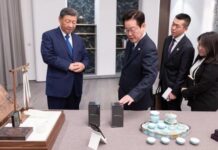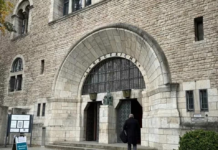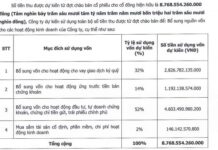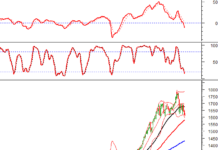Completed but Abandoned
During the period of 2004–2007, Ho Chi Minh City had a plan to invest in the construction of 30,000 apartments for resettlement purposes within the city and 12,500 apartments in the new Thu Thiem Urban Area. Some projects had prolonged construction periods, delayed resettlement arrangements, high operating costs, and low efficiency, resulting in a waste of investment capital from the state budget. Prolonged vacancy has led to severe deterioration of the buildings. Completed supermarkets, hospitals, and schools also remain non-operational, causing further waste of resources.
A notable example is the Binh Khanh Resettlement Area in Thu Duc City, located in the center of the new Thu Thiem Urban Area, covering an area of 38.4 hectares with dozens of massive apartment blocks. This largest resettlement area in Ho Chi Minh City has 12,500 apartments and was completed in 2015. However, since then, many apartment blocks have remained closed and are now abandoned.

The “golden land” plot at 33 Nguyen Du and 34 – 36 – 42 Chu Manh Trinh left abandoned and used as a parking lot
Similarly, the Vinh Loc B Resettlement Area in Binh Chanh District is also facing a deserted situation. With an investment capital of VND 1,000 billion for 529 land plots and 1,939 apartments, this housing area was put into operation in 2011. The Vinh Loc B Resettlement Area was built with supporting facilities such as supermarkets, sports areas, and schools, but most of the families assigned to this area were from resettlement projects on Bui Vien Street, Tham Luong Canal, and some inner-city renovation programs. They were reluctant to move to this area due to its distance from the city center.
According to Mr. Le Hoang Chau, Chairman of the Ho Chi Minh City Real Estate Association (HoREA), it is necessary to conduct sociological surveys before land retrieval for projects and provide multiple resettlement options for affected residents. Sociological surveys will help authorities understand the needs, circumstances, livelihoods, and wishes of those whose land is being retrieved, ensuring that land retrieval, compensation, support, and resettlement processes are practical and aligned with the people’s needs, thus avoiding the surplus of resettlement housing as seen in recent years.
According to Mr. Dinh Thien Tan, Head of the Management and Operation Division of the Ho Chi Minh City Department of Construction, the city currently has nearly 9,000 resettlement apartments waiting to be allocated to displaced residents from various projects. Among these, the Center for Housing and Construction Supervision manages nearly 8,500 apartments. These resettlement apartments are scattered across districts and Thu Duc City. Some areas with a large number of vacant apartments include the Binh Khanh Resettlement Area with more than 5,300 units, 320 apartments in District 12, over 220 apartments in Tan My Apartment Building in District 7, and 470 resettlement apartments in Binh Thanh District, all of which are sparsely populated.
Mr. Tan shared that since these apartments are unoccupied, they are closed and sealed, with no maintenance or upkeep costs incurred. However, Ho Chi Minh City has to pay management and operation fees to the management boards of these projects. Currently, there are 39 apartment projects with documents and notifications from the management boards, management units, and Public Service Companies requesting the settlement of management and operation fees for vacant apartments managed by the Center, totaling more than VND 81 billion.

Binh Khanh Resettlement Area in Thu Duc City showing signs of deterioration with overgrown grass
Mr. Tan also mentioned that Decision No. 2880/QD-UBND states that the authority to attend apartment building conferences and participate in the management boards is only given to those who have been assigned resettlement apartments, temporary residences, or have signed contracts to rent, rent-to-own, or purchase apartments under state ownership. However, the Center for Housing and Construction Supervision has not yet been authorized by the Ho Chi Minh City People’s Committee to attend these conferences and participate in the management boards. As a result, the Center cannot attend in the capacity of the owner to vote for the management board of the apartment building and agree on the management and operation unit price for the vacant apartments it manages.
Additionally, the Center for Housing and Construction Supervision has not been assigned the responsibility for paying management and operation fees to the management boards. “The solution lies in legal regulations, so for now, we are only monitoring, sealing, and locking the apartments,” said Mr. Tan. At present, the Center has compiled and reported to the Department of Construction to advise and propose to the Ho Chi Minh City People’s Committee to authorize the Center to attend apartment building conferences, participate in management boards, and pay management and operation fees for vacant apartments under its management.
Waste of “Golden Land”
The Center for Housing and Construction Supervision is also managing 44 addresses of public houses and land under Decree No. 167. Among these, 5 addresses are for rent, while 39 others are vacant. In addition, the Steering Committee 167 is submitting to the Ho Chi Minh City People’s Committee for approval to assign the Center for Housing and Construction Supervision to manage (in the first phase) 343 addresses from the districts and 68 addresses from the Ho Chi Minh City Limited Liability One-Member Company for Managing and Trading in Housing. According to the plan, the Ho Chi Minh City People’s Committee is expected to assign the Center to receive and manage the operation of more than 1,000 addresses of houses under Decree No. 167. However, due to the lack of a rental mechanism, many addresses of houses and land remain unused, resulting in waste.
According to the Ho Chi Minh City Department of Construction, the Law on Management and Use of Public Assets does not stipulate that the People’s Committees of the provinces are responsible for issuing the minimum rental rates for houses and land used for production and business purposes. Therefore, the Ho Chi Minh City People’s Committee does not have a basis for issuing rental rates for houses and land used for production and business activities. Currently, the government is developing a draft decree on regulations for the management, use, and exploitation of houses and land that are public assets but not used for residential purposes, which will be managed and exploited by local housing management and trading organizations.
In addition, Ho Chi Minh City also has a series of “golden land” plots that have been left abandoned for decades. A typical example is the Phan Dinh Phung Sports Center project with four facades on Pasteur, Nam Ky Khoi Nghia, Vo Van Tan, and Nguyen Dinh Chieu streets in District 3. This project was approved by the Prime Minister for investment in the form of a BT (build-transfer) contract in 2008 and started construction in March 2010, with an initial announced investment of VND 988 billion. By 2013, the project’s value had increased to over VND 1,352 billion. By 2016, the feasible investment capital had reached over VND 1,953 billion, double the initial amount. However, up to now, the site remains empty.
At the end of April 2024, Chairman of the Ho Chi Minh City People’s Committee, Mr. Phan Van Mai, announced the conclusion that the Phan Dinh Phung Sports Center project, invested in the form of a BT contract, would be revoked and switched to public investment after 10 years of delay. Currently, relevant departments and branches are reviewing the legal basis, inspecting the work that the investor has completed, and determining the costs for negotiation and final settlement based on reasonable and harmonious principles. The new investment policy for the project will be submitted to the Ho Chi Minh City People’s Council at the July session, with the capital source allocated for the 2021-2025 period, and the project is expected to commence before April 30, 2025.
Right in the center of District 1, there are also 26 “golden land” plots with a total area of tens of thousands of square meters. Of these, 15 projects have left the land vacant, and 11 are under construction. These land plots are causing losses, waste, and negatively impacting the cityscape of Ho Chi Minh City, such as the land plot at 2 – 4 – 6 Hai Ba Trung, the “golden land” plot at 33 Nguyen Du and 34 – 36 – 42 Chu Manh Trinh, the land plot at 8 – 12 Le Duan with four facades, the SJC Tower project in the Le Thanh Ton – Nam Ky Khoi Nghia – Nguyen Trung Truc – Le Loi quadrangle, and the 9,000m2 site of the former Tax Trade Center, which was demolished in 2016, at the corner of Nguyen Hue and Le Loi streets.
According to Mr. Phan Van Mai, Chairman of the Ho Chi Minh City People’s Committee, in the future, the city will continue to apply Resolution 98 and Conclusion 14 of the Politburo to propose the temporary exploitation of golden land and unused public land. After deducting management costs, the revenue will be added to the state budget.





































